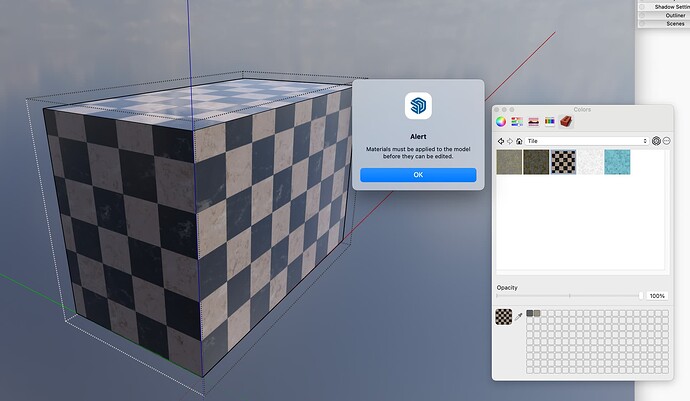I saw that this topic has been posted before, but that was back in 2020.
I am having trouble editing materials. When I right click on the material in the model ther are no options to edit it. So I go into the materials panel and right click on the material thumbnail and I keep getting a pop up message saying “Materials must be applied to the model before they can be edited.” I have applied the material to the model!!! I’ve tried restarting Sketchup, that didn’t work. I opened a different file and I keep getting the same thing. This is a huge problem if I can’t edit a material. Whats going on???
That indicates you’ve applied the material to the object (component or group) instead of the faces. Apply the material to the faces instead and you’ll get the Texture menu item in the Context menu.
Restarting SketchUp won’t fix this. You cannot edit materials in their collections. You must switch to the In Model materials (click on the house icon) and then select the material. You’ll be able to edit it in the Edit tab then.
Are you looking at the in model collection when you try to edit them?
Edit Dave beat me to it..,
For your interest, with Windows you can only edit the in model materials, though it does have a convenience thing where if you dare to edit a material in a collection, it still connects you to the in model copy.
On Mac you could appear to edit the material in a collection, but if you saved the changes they weren’t remembered. There also was a combination of actions that led to a crash.
So, instead of fixing those two issues the Mac version was made to match what happens on Windows, and you are told that you can only edit the material in the In Model set. Alas, it doesn’t have the convenient redirect that occurs on Windows, so you manually have to select In Model before editing the material.
Thank you. This worked. Although its a bit frustrating to have to go into a group/component and apply manually to each face.
I guess you don’t have to do that if the material doesn’t have a direction.
You could use an extension called Thru Paint if you want.
Applying textures to the faces instead of the containers has benefits over applying them to the group or component containers but it’s your choice to take advantage of them or not.
It’s supposed to be a feature. The default textures is actually a placeholder, rather than an actual texture. When you paint outside of a group or component, it only applies to whatever has the default color inside, and everything else is unchanged. The classic example is an automobile component where the body is the default and everything else like glass and tires is painted inside. One component can serve to make a red car, a green car and a blue car without being unique components.
When you deal with wood or other texture with direction you will be happy for this feature.



